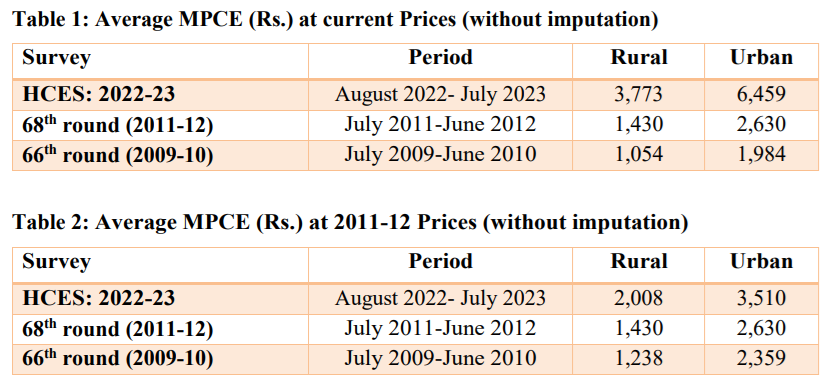
India’s Monthly Household Consumption Expenditure data released by the ministry of statistics and programme implementation last week has ignited conversations on the poverty numbers, consumption patterns, and the rural-urban divide. The publication of HCES data after an eleven-year hiatus offers a rare window into the spending habits of Indian households, yet it also raises some critical questions regarding the methodology employed and the interpretations.
At the heart of the debate is the comparability of the current survey with its predecessors. The HCES for 2022-23 introduces significant methodological changes, including the segmentation of questionnaires and multiple household visits, aimed at refining data collection. While these adjustments are theoretically sound, enhancing the precision of responses, they inadvertently complicate direct comparisons with past surveys. The addition of 405 consumption items, up from 347 in the previous round, further underscores the evolving consumption patterns and layers of complexity in drawing historical comparisons.
READ I WTO ministerial: India flexes muscles amid stalemate on e-commerce
HCES data: Questions over methodology
The divergence in data collection methodologies presents a quandary. On one hand, it acknowledges the dynamic nature of consumption patterns, necessitating updates to survey instruments. On the other, it muddies the water for analysts attempting to trace consumption trends over a decade. The introduction of separate surveys for different categories of expenditure and the inclusion of imputed values for items received via social welfare programmes represent efforts to capture a more nuanced picture of household consumption. However, these changes raise questions about the upward bias in estimates and the challenge in assessing the validity of imputed values without detailed unit-level data.


Technological advancements have revolutionised data collection methods, offering both opportunities and challenges for surveys like the HCES. The increased use of digital devices and online platforms has the potential to improve the accuracy and efficiency of data gathering. However, it also raises questions about privacy, data security, and the digital divide. The extent to which technology has been leveraged in the latest HCES to mitigate respondent fatigue, improve response rates, and ensure representative sampling across diverse socio-economic groups remains unclear. Embracing technology in data collection, while addressing its pitfalls, is crucial for capturing a true picture of household consumption patterns.
Shifting consumption patterns
The preliminary findings from the HCES suggest a narrative of declining poverty, a narrowing rural-urban divide, and shifting consumption patterns away from food towards a more diversified basket of goods and services. This narrative, while encouraging, must be approached with caution. The reported decline in the share of food expenditure, both in rural and urban areas, and the apparent reduction in consumption inequality, signal shifts in economic behaviour and potentially, living standards. Yet, the reliance on a revised methodological framework may distort the true extent of these trends.
The interplay between inflation and consumption expenditure is a critical yet underexplored dimension in the analysis of HCES data. While the survey provides nominal figures of consumption expenditure, understanding real changes in consumption patterns requires adjusting these figures for inflation. The period since the last survey has witnessed significant economic events, including demonetisation and the COVID-19 pandemic, which have had complex impacts on inflation rates and, consequently, on the purchasing power of households. Without a nuanced analysis that accounts for inflation, conclusions drawn about improvements in living standards and reductions in poverty may be misleading.
Moreover, the survey’s indication of unchanged or marginally improved inter-caste disparities in consumption expenditure highlights the persistent structural inequalities within Indian society. While urban areas show some progress in narrowing inter-group consumption gaps, rural India remains largely unchanged, pointing to the deep-rooted nature of these disparities.
The data also reveal intriguing state-wise variations in consumption, challenging popular narratives around development models. The comparison between states like Uttar Pradesh, Gujarat and Kerala, based on their consumption figures, opens up a broader discourse on the efficacy and inclusiveness of different developmental approaches.
While the release of the HCES findings is a step forward in understanding Indian economy, it also underscores the critical need for transparency and rigour in data collection and analysis. The discrepancies between the consumption expenditure reported by households and the private final consumption expenditure from national income accounts highlight a significant gap in our understanding of economic well-being. This gap, attributed to underreporting by wealthier sections of society, calls into question the completeness and accuracy of the survey data.
As India continues to move in the path of economic growth and diversification, the insights gleaned from the HCES are invaluable. However, for these insights to truly inform policy and contribute to a nuanced understanding of well-being, a concerted effort is needed to bridge methodological gaps, ensure comparability across surveys, and address the challenges posed by evolving consumption patterns. The balancing act between capturing the dynamic nature of consumption and maintaining consistency in survey instruments is complex but not insurmountable, as evidenced by longitudinal panel surveys from other countries.
The HCES data holds profound implications for policy formulation, particularly in areas related to social welfare, economic inequality, and fiscal policy. The survey’s insights into changing consumption patterns, especially the reduction in food expenditure and the diversification of the consumption basket, should inform the recalibration of social welfare schemes and subsidies.
Moreover, the persistent rural-urban and inter-caste disparities underscore the need for targeted interventions. However, the efficacy of such policy measures is contingent upon the reliability and comprehensiveness of the data. Policymakers must tread carefully, acknowledging the methodological limitations of the HCES, to craft policies that are responsive to the evolving needs and challenges of India’s diverse population.
While the HCES provides a much-needed update on the consumption expenditure of Indian households, its findings must be seen with a critical eye. The survey opens up new vistas for understanding Indian economy but leaves many questions unanswered. For policymakers, researchers, and the public, the data offer a deeper understanding of India’s economic realities, and underscores the need for methodological integrity, transparency, and inclusivity of government statistics.
